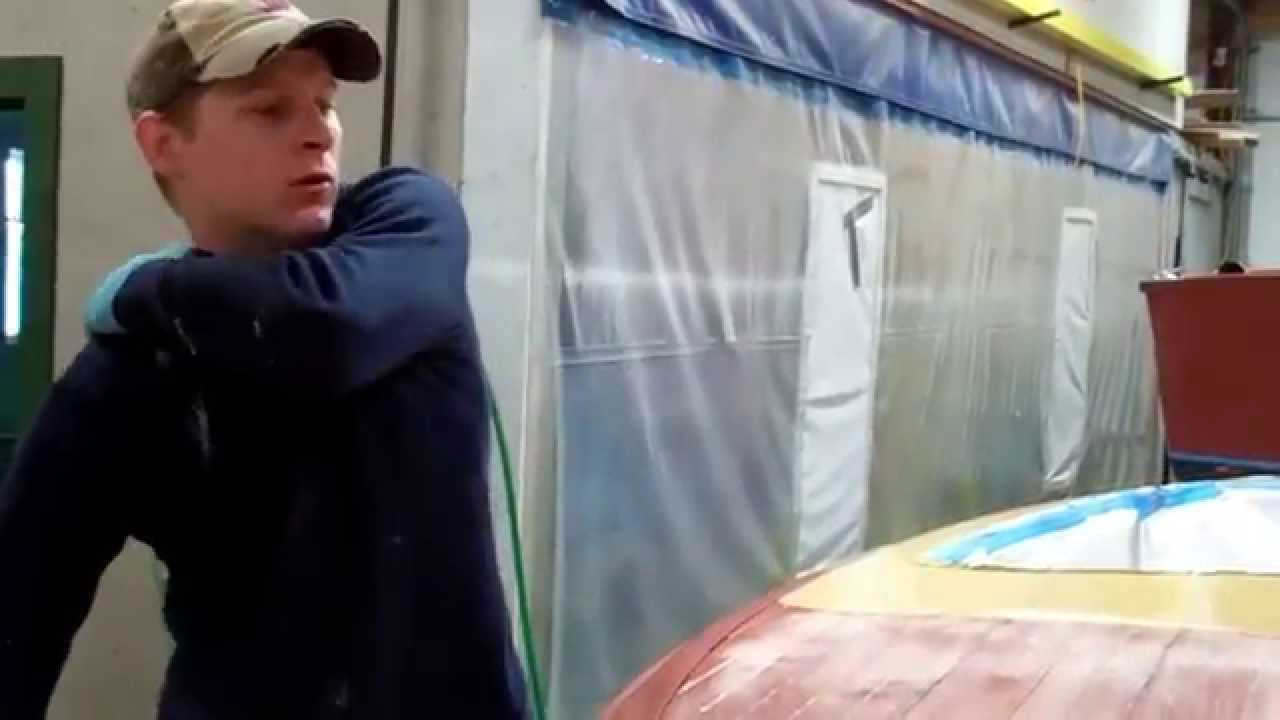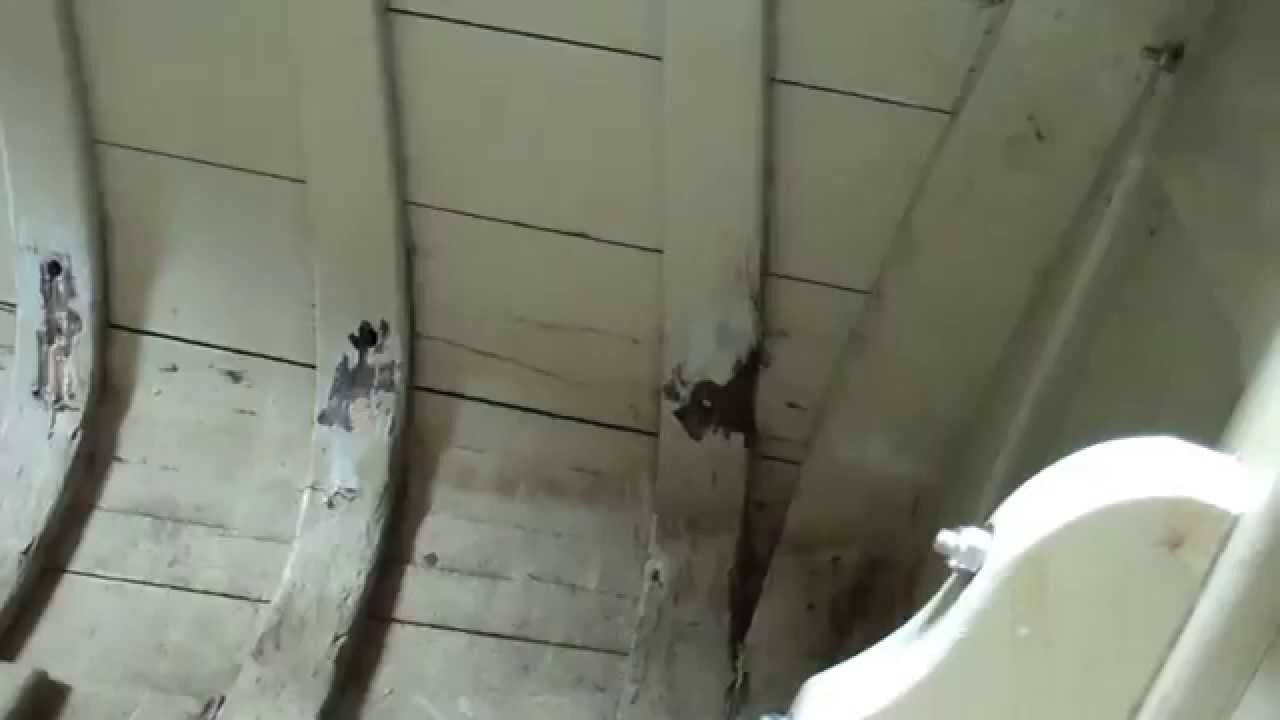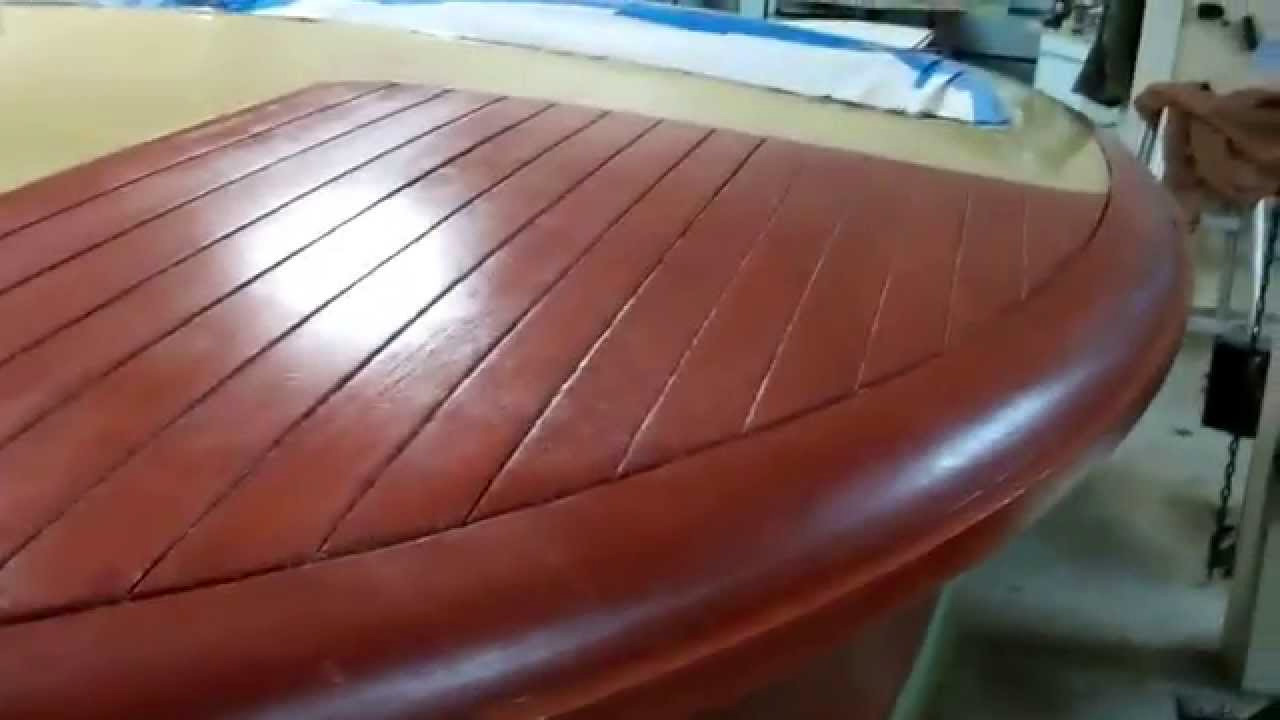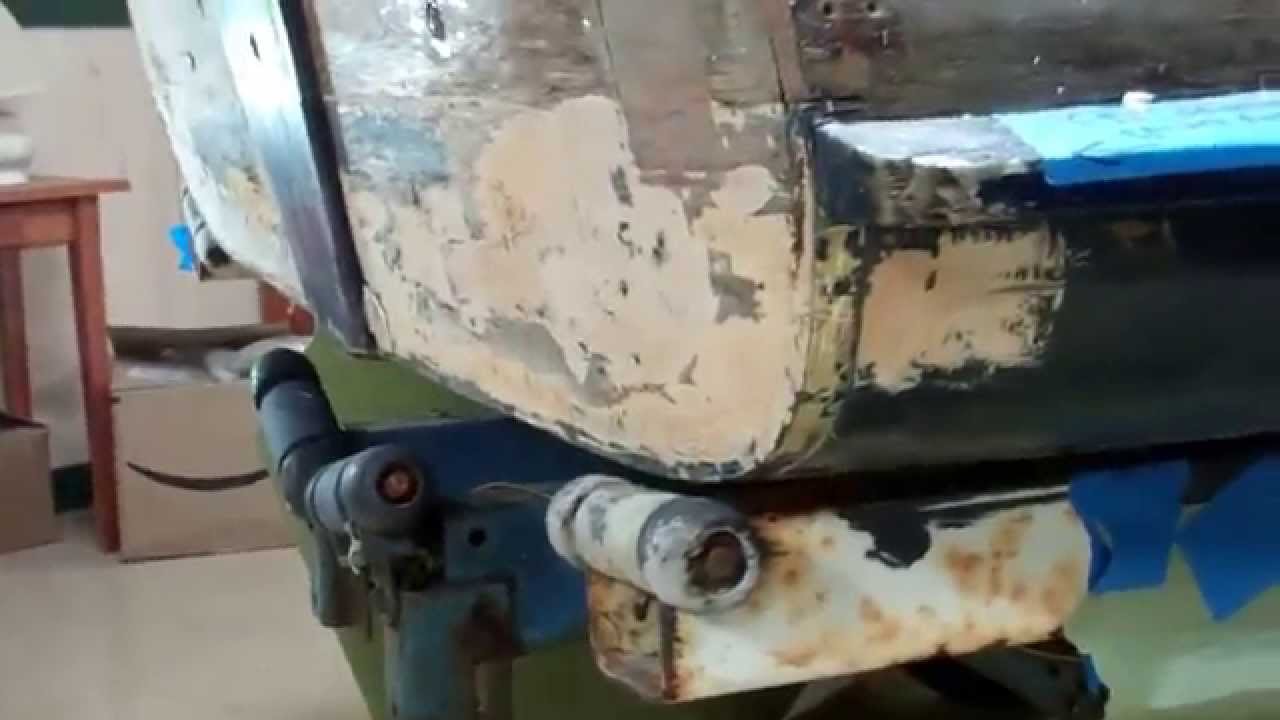We allowed the Interlux Interprime Clear Sealer to cure in the paint/varnish clean room over the weekend. Now the fun begins.
RJ will sand the entire boat using a pneumatic random-orbit sander and 200 grit paper. His goal is getting as close as he can to flat without cutting through the sealer. Eventually he will sand the surfaces until he has a uniform snow field, but we won’t see that stage until we are about 5 coats into the process.
We will then return the boat to the paint/varnish clean room where she will lie in its 65 degree environment for 24 hours, by which time the boat’s surface should have reached the critical temperature.
Temperature and humidity affect how much thinner we add and how the varnish lays down. We shoot for 60-65 percent humidity and 65 degrees.
As is our practice, Pettit Hi-Build gloss varnish will be applied with a 3” foam roller followed by tipping immediately using a 3” Wooster varnish brush. RJ is our go-to varnish guy, while John and I are relegated to tipping behind him.
She will only become more and more stunning with each coat which we will chronicle in future updates.
57 Penn Yan Captivator Stripping Milestone 12 10 2014
DescriptionIt was a long, long day. With heat gun in hand, RJ completed stripping the coamings and the dash, but the starboard topsides were all mine.
Several of you questioned why I am not using a chemical stripper like Circa 1850 on the painted splash rails and eventually the bottom. We cannot be sure that we are not dealing with lead paint. Since lead will not vaporize below 1,000 F, so we set our guns at 900 F, which keeps the lead encapsulated with the scrapings, which remain dry and safe to handle.
RJ carefully released the stem-to-stern long spray rails, despite the forest of sheetrock screws from the outside-in, and an even denser forest of stainless square drive screws driven from inside and through the topsides every 8-010 inches. Happily with a bit of repair using Total Boat Thixio thickened epoxy, the starboard spray rail can be saved.
And the best news of all is that there is no rot in the topside planks behind the spray rails. We did unearth some rot in the three aft-most starboard ribs. The ribs will be sistered using steam-bent white oak.
The aft section of the port rail must be fabricated anew. We will match the factory scarf joint found on the starboard side, thereby producing a result that, other than the new white oak, matches the original design.
I misspoke in the video when I said she is ready to move into the main shop and flip. Before that can happen we must extract all of the residual black walnut stain out of the mahogany topsides, decks, coamings, etc. using Circa 1850 Heavy Body remover, scrapers, brass brushes and repurposed stainless kitchen scouring pads.
1957 Penn Yan Captivator Stripping Milestone
It was a long, long day. With heat gun in hand, RJ completed stripping the coamings and the dash, but the starboard topsides were all mine. Several of you questioned why I am not using a chemical stripper like Circa 1850 on the painted splash rails and eventually the bottom. We cannot be sure that we are not dealing with lead paint. Since lead will not vaporize below 1,000 F, so we set our guns at 900 F, which keeps the lead encapsulated with the scrapings, which remain dry and safe to handle. RJ carefully released the stem-to-stern long spray rails, despite the forest of sheetrock screws from the outside-in, and an even denser forest of stainless square drive screws driven from inside and through the topsides every 8-010 inches. Happily with a bit of repair using Total Boat Thixio thickened epoxy, the starboard spray rail can be saved. And the best news of all is that there is no rot in the topside planks behind the spray rails. We did unearth some rot in the three aft-most starboard ribs. The ribs will be sistered using steam-bent white oak. The aft section of the port rail must be fabricated anew. We will match the factory scarf joint found on the starboard side, thereby producing a result that, other than the new white oak, matches the original design. I misspoke in the video when I said she is ready to move into the main shop and flip. Before that can happen we must extract all of the residual black walnut stain out of the mahogany topsides, decks, coamings, etc. using Circa 1850 Heavy Body remover, scrapers, brass brushes and repurposed stainless kitchen scouring pads.
1952 Chris Craft Riviera Runabout Sealed First Coat
As promised, here is the Riviera following applying the first coat of sealer. As I say in the clip, I have been engaged in lots of reading and research around issues of chemical incompatibility, during which a possible conflict between Interlux Interstain Wood Filler stain and CPES popped up several times.
Under “certain circumstances,” and especially if the stain is not fully cured, applying the CPES over the Interlux stain can cause the stain to lift and bubble.
Interlux recommends applying two coats of its Interprime Wood Sealer (1206 clear) over Interstain, so we are turning my Riviera into our guinea pig.
What I noticed first is a virtual complete absence of VOCs, unlike Smith’s CPES’s VOCS, which assault whoever is near it.
And, unlike CPES, which drags if the brush strays too far onto areas already soaked in the material, we were able to roll and tip Interprime using a 3” yellow foam roller and a chip brush without experiencing any drag.
Interlux explicitly stipulates no sanding between coats on anything but plywood, where we always sand between coats with CPES.
However, where we can safely recoat CPES, Interprime wants 16 hours at 77 F between coats. (No way do we keep the shop at 77F;
I am very pleased by how the Interprime caused the stain to blossom to the rich red mahogany hue we are after. CPES would not give us this result.
We will report again following tomorrow’s second coat.
’52 Chris Craft Riviera Runabout Sealed First Coat
As promised, here is the Riviera following applying the first coat of sealer. As I say in the clip, I have been engaged in lots of reading and research around issues of chemical incompatibility, during which a possible conflict between Interlux Interstain Wood Filler stain and CPES popped up several times.
Under “certain circumstances,” and especially if the stain is not fully cured, applying the CPES over the Interlux stain can cause the stain to lift and bubble.
Interlux recommends applying two coats of its Interprime Wood Sealer (1206 clear) over Interstain, so we are turning my Riviera into our guinea pig.
What I noticed first is a virtual complete absence of VOCs, unlike Smith’s CPES’s VOCS, which assault whoever is near it.
And, unlike CPES, which drags if the brush strays too far onto areas already soaked in the material, we were able to roll and tip Interprime using a 3” yellow foam roller and a chip brush without experiencing any drag.
Interlux explicitly stipulates no sanding between coats on anything but plywood, where we always sand between coats with CPES.
However, where we can safely recoat CPES, Interprime wants 16 hours at 77 F between coats. (No way do we keep the shop at 77F;
I am very pleased by how the Interprime caused the stain to blossom to the rich red mahogany hue we are after. CPES would not give us this result.
We will report again following tomorrow’s second coat.
1957 Penn Yan Captivator Stripping Continues
This video contains a plea, “If you do not know how to repair rotted members, please do not try. You only make matters worse.”
And whoever had his/her hands on this boat clearly lacked the knowledge, but did not allow that fact to stand in the way of what must be the most abysmal work we have seen, and now must undo to date.
The aft half of the part spray rail must have begun rotting. In fact , as is clear in the clip, the rot had progressed well beyond “just starting.” The below-waterline transom plank was in even more severe dire straits. Band aids do not a proper repair make.
Indeed, what was done to the spray rail only succeeded in trapping water and propelling the rot, as you can see by viewing the aft-most foot or so. A proper repair, releasing the rail and replacing the rotted aft section using a scarf joint, must have been well beyond this person. Better to glop the goo into place and hope for the best.
We must carefully release the rail, if only to see what trapped water has done to the planking behind it, and then fabricate a new section that will be scarfed to the forward portion.
But the transom work is truly special. All the filler that is visible along the entire lower edge of the bottom plank made me wonder is any of it had survived. When my scraper blade unearthed a brass strip nailed across the entire bottom of the transom and riding on the bottom planking, I knew. No wood had survived so the wood putty was inserted into the void across the entire bottom edge of the transom.
Then there is the rest of this plank, a good 70% of it being completely gone and replaced with more putty.
What is our plan forward? I just do not know until we have flipped the boat to reveal the bottom planking. As you can see at one point in the clip, I have already revealed more wood putty just ahead of the transom where the first bottom plank and it meet.
I fear that my adventures with wood putty have just begun.
1952 Chris Craft Riviera Runabout Staining Complete
We passed a significant milestone on the 1952 Chris-Craft Riviera runabout 18’ with completing staining the entire hull.
The blonde sections had been stained, sealed and received an initial two coats of Pettit Hi-Build gloss varnish before we began staining the remainder of the decks, covering boards, transom and topsides this afternoon.
We applied Interlux Intersatin, 2 parts #573 to 1 part #42, Don Danengerg’s favorite combination. After allowing the stain to flash, a process by which the initially shinny and greasy surface morphs into a dull matte finish.
Then the fun begins as the thinner continues gassing off and scrubbing cross-grain with cheese cloth and terrycloth towels becomes ever-more difficult with each passing minute. For this reason, we always stain large boats such as the 18’ Riviera in sections.
You will arrive at a moment where you feel, “Finally, we are done.” Probably not. Grab several sheets of cheese cloth folded into a polishing pad and do a final buffing over the entire surface. The cloth stays pretty clean while the surface becomes lustrous. Now you are done.
Applying three coats of CPES tomorrow morning is next. It will be followed by a very light scuff sanding with 120 grit, and then the boat moves to the paint room where we will begin building what will eventually be at least 15 coats of Pettit Hi-Build varnish.
’52 Chris Craft Riviera Runabout Staining Complete
We passed a significant milestone on the 1952 Chris-Craft Riviera runabout 18’ with completing staining the entire hull.
The blonde sections had been stained, sealed and received an initial two coats of Pettit Hi-Build gloss varnish before we began staining the remainder of the decks, covering boards, transom and topsides this afternoon.
We applied Interlux Intersatin, 2 parts #573 to 1 part #42, Don Danengerg’s favorite combination. After allowing the stain to flash, a process by which the initially shinny and greasy surface morphs into a dull matte finish.
Then the fun begins as the thinner continues gassing off and scrubbing cross-grain with cheese cloth and terrycloth towels becomes ever-more difficult with each passing minute. For this reason, we always stain large boats such as the 18’ Riviera in sections.
You will arrive at a moment where you feel, “Finally, we are done.” Probably not. Grab several sheets of cheese cloth folded into a polishing pad and do a final buffing over the entire surface. The cloth stays pretty clean while the surface becomes lustrous. Now you are done.
Applying three coats of CPES tomorrow morning is next. It will be followed by a very light scuff sanding with 120 grit, and then the boat moves to the paint room where we will begin building what will eventually be at least 15 coats of Pettit Hi-Build varnish.
1930 Dodge Bros 16 5′ Runabout Project Update 12 8 2014
Minnow is a 1930 Dodge Bros. 16.5’ runabout who is incredibly original, from her gauges to her quite unique push/pull throttle and Lycoming flathead 4 engine.
Her engine will ride Old Dominion to Robert Henkel Inc. (http://ift.tt/1w7jSRy) in Harsens Island, MI to be completely rebuilt to as close to original as is possible. Given his life-long association with antique and classic wood boats, and especially his well-deserved reputation for delivering work that meets the highest standards of craftsmanship, we are pleased that he agreed to take on this rebuild responsibility.
Our focus for now is the interior of the hull and installing a new 5200 bottom that matches the original planking pattern exactly.
Here we, well John is “tooth-picking” every fastener hole in the bottom framing. Why? Once the Gorilla glue sets, we will cut every tooth pick off flush with the framing using our Multi-master Fein tool, A quick sanding followed by coating with bilge paint fives us a surface into which the new fasteners can bite and hold.
The interior layer of Okoume plywood comes next, the templates for which John fabricated using heavy industrial paper. Once each panel is fitted, its interior face will receive three coats of CPES and two coats of Sandusky Chris-Craft Mahogany bilge paint. The exterior surface will be treated similarly once it is installed.
But all that will be covered in upcoming progress reports. For now enjoy Minnow a’ la porcupine. By the time John finishes, he will have consumed close to 5,000 toothpicks and more than a pint of Gorilla glue.
Thank youu to her Oregon-based owners for entrusting preparing Minnow for next season following languishing on the hard for the last 45+ years!
1957 Penn Yan Captivator Stripping Update
It is Saturday and the Captivator project continues. The decks and most of the gunwales are stripped, complete with bleed black walnut stain out of the mahogany planking. Now comes the topsides.
I began as I typically do, applying Circa 1850 Heavy Body Paint and Varnish Remover to the surface. As expected, puddles and curtains began forming, which quickly soaked the cardboard sheets on the floor.
Not expected, however, was the discovery that, once liquefied anew, what appears to have been some sort of dark walnut stain varnish began bleeding black into the mahogany. No, I did not smile. An Old School, heat gun and scraper strategy appears to have saved the day. Operating the De Walt heat gun at between 900 and 1,000 degrees F releases the adhesion between the mahogany and the stain-varnish. While I must go back and bleed black stain out of the wood fibers, at least I am not adding to that challenge while I strip the varnish off the surface.
Once the varnish is released I will go back with the Circa 1850 and BAHCO scrapers so that the mahogany ends up free of adulteration, at least as best we can attain before we begins anding with our pneumatic long boards.
Releasing finishes offer s a critical opportunity for discovering fastener and framing issues. Applied to the Captivator, I have learned that the foredeck planks are floating free at the bow, and that there is a serious structural design/failure to be dealt with where the aft deck inserts into the gunwale framing.
We will continue stripping in the manner, hoping to have the hull and transom clean above the spray rails by Monday morning, when we plan to move the Captivator so we can flip her and begin working below her waterline.






